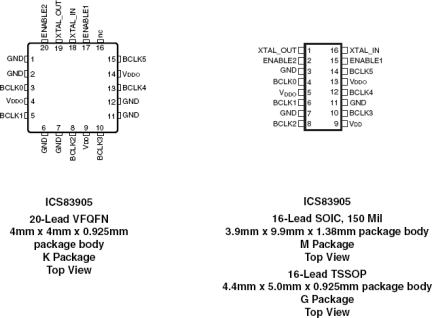概要
説明
The 83905 is a low skew, 1-to-6 LVCMOS / LVTTL Fanout Buffer. The low impedance LVCMOS/LVTTL outputs are designed to drive 50Ω series or parallel terminated transmission lines. The effective fanout can be increased from 6 to 12 by utilizing the ability of the outputs to drive two series terminated lines. The 83905 is characterized at full 3.3V, 2.5V, and 1.8V, mixed 3.3V/2.5V, 3.3V/1.8V and 2.5V/1.8V output operating supply mode. Guaranteed output and part-to-part skew characteristics along with the 1.8V output capabilities makes the 83905 ideal for high performance, single ended applications that also require a limited output voltage.
特長
- Six LVCMOS / LVTTL outputs
- Outputs able to drive 12 series terminated lines
- Crystal Oscillator Interface
- Crystal input frequency range: 10MHz to 40MHz
- Output skew: 80ps (maximum)
- RMS phase jitter @ 25MHz, (100Hz – 1MHz): 0.26ps (typical), VDD = VDDO = 2.5V
Offset Noise Power
100Hz.................-129.7 dBc/Hz
1kHz...................-144.4 dBc/Hz
10kHz.................-147.3 dBc/Hz
100kHz...............-157.3 dBc/Hz - 5V tolerant enable inputs
- Synchronous output enables
- Operating power supply modes:
Full 3.3V, 2.5V, 1.8V
Mixed 3.3V core/2.5V output operating supply
Mixed 3.3V core/1.8V output operating supply
Mixed 2.5V core/1.8V output operating supply - 0°C to 70°C ambient operating temperature
- Available in lead-free (RoHS 6) package
製品比較
アプリケーション
設計・開発
モデル
ECADモデル
[製品選択]テーブル内の製品名をクリックするとSamacSysが提供する回路図シンボル、PCBフットプリント、3D CADモデルがご確認いただけます。 お探しのシンボルやモデルが見つからない場合、Webサイトから直接リクエストできます。

ビデオ&トレーニング
Description
Provides an overview of the features and benefits of IDT's industry-leading fanout buffer and clock distribution portfolio. Fanout buffers are a useful building block of many clock trees, providing signal buffering and multiple low-skew copies of the input signal. The clock fanout from a single input reduces loading on the preceding driver and provides an efficient clock distribution network. Presented by Vik Chaudhry, technical marketing manager at IDT. For more information about Renesas's clock IC timing solutions, visit the Clock Buffers & Drivers page.
Transcript



